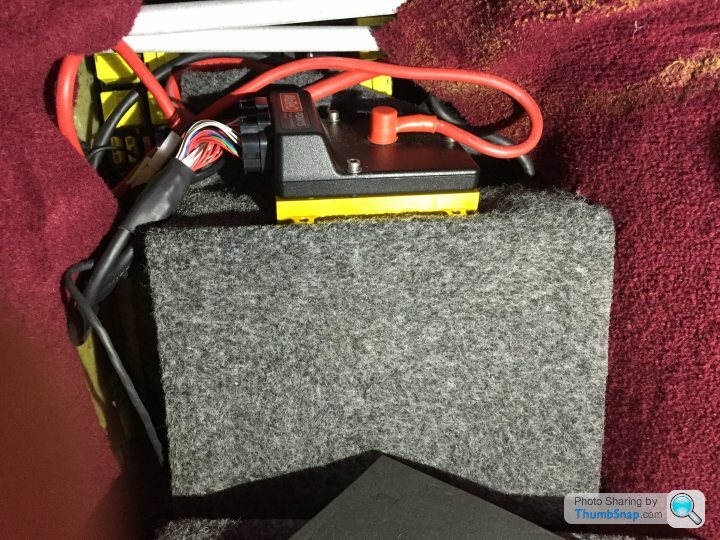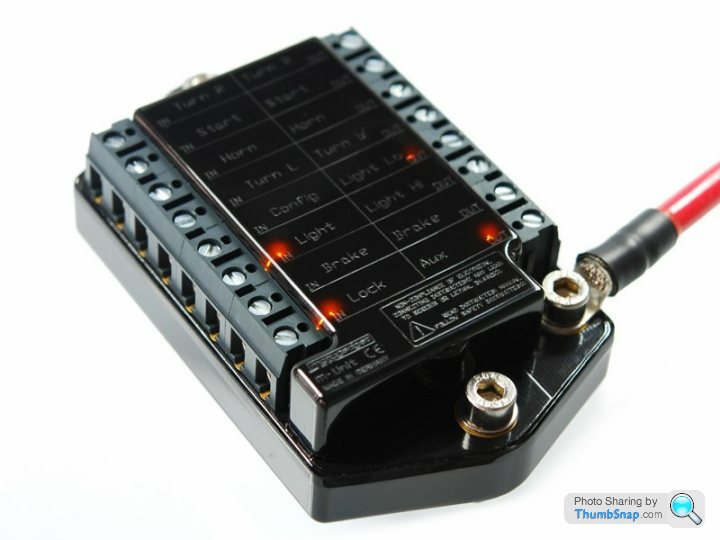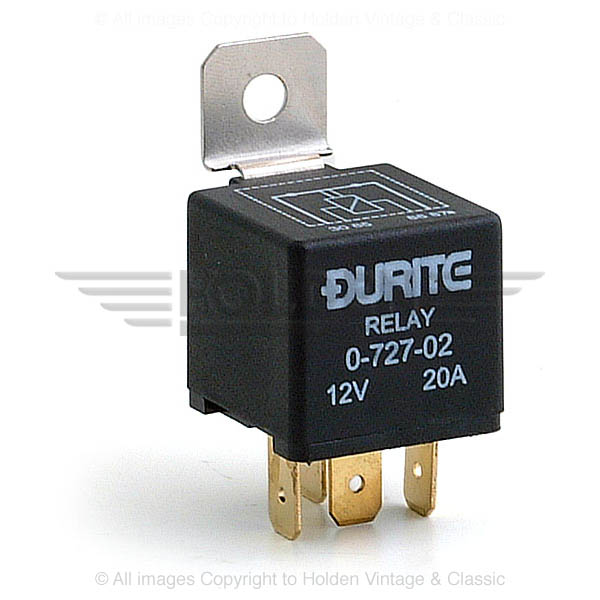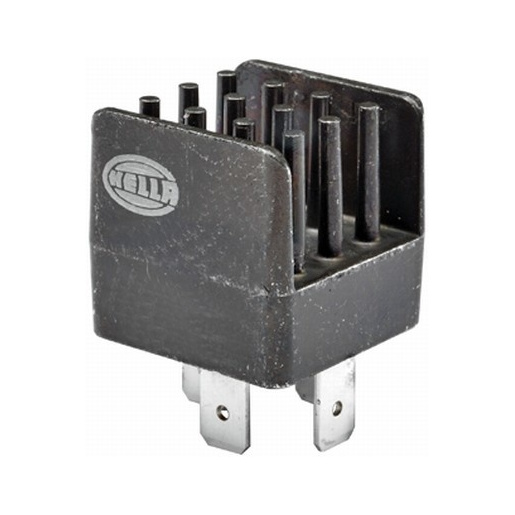Solid State Power Distribution Modules - Clearly The Future!
Discussion
I see Nigel [Hoofa] has just fitted a very interesting bit of kit that I thought deserved it's own topic rather than being just a brief post on the... What did you do in the garage yesterday? topic.

The matter-of-fact way Nigel has presented his latest addition is typically modest, but it strikes me such solid state power distribution modules are the future and could be the biggest step forward in after market automotive wiring since the introduction of mechanical relays in the 1970's.
Looking at the MoTeC and RacePck versions they do seem very race car focussed, but I see motorcycle builders are already enjoying a greatly simplified stand alone version from MotoGadget:

http://motogadget.com/en/electrics/electronic-cont...
The stand alone MotoGadget m-Unit V.2 is not really suitable for a car simply because it only offers control of 8 circuits so I'd love to see an expanded 30 pin in & out version, surely it would be the perfect product for the kit car, hot rod builder and classic car restoration world?
In our case deleting the TVR fuse board and replacing ALL the relays and fuses with a solid start controller board would be a massive step forward, an automotive relay typically has a service life of 30,000 cycles which sounds like a lot until you realise going solid state instantly changes this figure to one million cycles.
Of course reliability is just one part of the story, in theory a solid state fuse/controller board offers a host of additional features and advantages over a traditional fuse board and relays, add a decent after market ECU and well made ECU/engine bay loom and you have the foundation to achieving massively enhanced TVR efficiency and reliability. The rest of the existing TVR loom can remain making the complete re-wire I often think our cars would really benefit from largely unnecessary, what you'd end up with is all the benefits while eliminating a massive chunk of the work.
This is clearly a very exciting discovery by Nigel, such solid state Power distribution modules are unquestionably the future of after market automotive wiring. But to me the best part of he story is this is a technology we can all benefit from as a retro-fit replacement to our traditional fuses & relays, so I thought it deserved it's own post where people can discuss the concept in more detail.

The matter-of-fact way Nigel has presented his latest addition is typically modest, but it strikes me such solid state power distribution modules are the future and could be the biggest step forward in after market automotive wiring since the introduction of mechanical relays in the 1970's.
Looking at the MoTeC and RacePck versions they do seem very race car focussed, but I see motorcycle builders are already enjoying a greatly simplified stand alone version from MotoGadget:

http://motogadget.com/en/electrics/electronic-cont...
The stand alone MotoGadget m-Unit V.2 is not really suitable for a car simply because it only offers control of 8 circuits so I'd love to see an expanded 30 pin in & out version, surely it would be the perfect product for the kit car, hot rod builder and classic car restoration world?
In our case deleting the TVR fuse board and replacing ALL the relays and fuses with a solid start controller board would be a massive step forward, an automotive relay typically has a service life of 30,000 cycles which sounds like a lot until you realise going solid state instantly changes this figure to one million cycles.
Of course reliability is just one part of the story, in theory a solid state fuse/controller board offers a host of additional features and advantages over a traditional fuse board and relays, add a decent after market ECU and well made ECU/engine bay loom and you have the foundation to achieving massively enhanced TVR efficiency and reliability. The rest of the existing TVR loom can remain making the complete re-wire I often think our cars would really benefit from largely unnecessary, what you'd end up with is all the benefits while eliminating a massive chunk of the work.
This is clearly a very exciting discovery by Nigel, such solid state Power distribution modules are unquestionably the future of after market automotive wiring. But to me the best part of he story is this is a technology we can all benefit from as a retro-fit replacement to our traditional fuses & relays, so I thought it deserved it's own post where people can discuss the concept in more detail.
Edited by ChimpOnGas on Monday 13th June 11:11
Sardonicus said:
Oh goody CANBUS  you wont convince anyone working on modern stuff Dave
you wont convince anyone working on modern stuff Dave  failed requests,unable to communicate,errors on the bus etc etc, I see to much of it so am slightly tarnished/tainted
failed requests,unable to communicate,errors on the bus etc etc, I see to much of it so am slightly tarnished/tainted  Alex will appreciate this post
Alex will appreciate this post 
As I understand it Simon CANBUS is more about a protocol that allows devices to communicate with each other, its also one of the family of standardised diagnostic protocols like OB2. That's not really what not what I'm talking about here, what I'm looking to discuss is the vastly simplified idea of replacing a traditional fuse/relay board with a stand alone solid state controller board. you wont convince anyone working on modern stuff Dave
you wont convince anyone working on modern stuff Dave  failed requests,unable to communicate,errors on the bus etc etc, I see to much of it so am slightly tarnished/tainted
failed requests,unable to communicate,errors on the bus etc etc, I see to much of it so am slightly tarnished/tainted  Alex will appreciate this post
Alex will appreciate this post 
In it's simplest form all I'm suggesting is replacing traditional mechanical relays we've all learnt to love/hate in in the last 35 years...

With one of these solid state jobbies...

Fundamentally all the MotoGadget motorcycle controller is doing is giving you the above solid state relay 8 times over for 8 circuits in one small simple to wire unit, Nigel's MoTeC system on the other hand is way more sophisticated and really designed for a race car ideally fitted with a CANBUS compatible ECU. The MoTeC also offers external PC programmability and was clearly designed to be CABUS compliant from the outset so if you have a CANBUS ECU you can pair the two units for even more functionality and controllability. All good stuff but it does add levels of complexity you could argue are unnecessary in our application.
Now, what if we could take the advantages of solid state switching and offer it in a simplified package, well that's exactly what the MotoGadget unit is giving to the motorcycle world already, it's a simple stand alone device designed to greatly simplify the process wiring up a motorcycle and has no real CANBUS functionality as we know it, so the way I see it if the simple MotoGadget unit just had four times the pins it would perfect for kit car builders and us alike.
It does however offer many additional advantages beyond reliability and the simplicity of installation, but what we're really looking at here is no different from changing from points to solid state electronic ignition, the advantages of which are well understood and accepted.
My guess is in the next few years these type of solid state fuse/controller boards will become the norm for kit car builders and the huge resto-mod scene in the USA, not to mention becoming popular with 1990's period classic car enthusiasts as a retro fit for their existing fuse/relay board.
The MotoGadget controller is rather motorcycle specific but it wouldn't take much to develop same concept making it more suitable for a car application.
https://www.youtube.com/watch?v=HNF-h6oBczg
I feel confident using such devices will become just as common place as replacing the points in your MGB with an electronic ignition kit is today.
At around £200 the simple but effective stand alone MotoGadget m-Unit V.2 isn't actually that expensive, but being rather motorcycle specific and only having 8 pins clearly makes it somewhat impractial for a car application. Saying that for around £800 you could buy four MotoGadget m-Unit V.2 units which would give you 32 pins and that should be sufficient, OK so I accept daisy chaining four of the MotoGadget units is less than ideal but it could be done and proves a car specific unit could be created at reasonable cost and within an acceptably small footprint.
My guess is people are looking at creating just such a simplified and cost effective car specific solid state controller already and we'll be seeing it come to market very soon. For a kit carbuiler starting his wiring project from scratch using this type of solid state board over a traditional fuse and mechanical relay board would surely be an absolute no-brainer, and with lots of relay heavy late 80's and early 90's cars already considered classics and so being restored, it's the perfect solution for that market too.
It doesn't need all the specific CANBUS ECU compatibility complication like Nigel's MoTeC unit has, as exciting as all that sounds it's neither essential or in many cases a desired feaure in the target market. Keeping things simple keeps the cost down, indeed all thats really needed here is a car specific version of the 8 pin MotoGadget motorcycle unit, just with 30 pins on offer and all in a single one box form factor for say around £500.
If you think about what it costs a kit car builer to buy a decent fuse board with 8 relays on it, a solid state board with 30 or so pins at £500 would actually only end up costing a fraction more. What the kit car builder or modern classic car restorer gets for a small additional outlay is a huge improvement in reliability and functionality in one simple to wire unit.
It's just the sort of thing David Hampshire of Canems Engine Management Systems could come up with, and before anyone accuses me of some sort of sneakily disguised promotion of an upcoming Canems product, I have absolutely no idea if such a board is in the pipeline.
It would be good though, so do hope he's listening.
My guess is people are looking at creating just such a simplified and cost effective car specific solid state controller already and we'll be seeing it come to market very soon. For a kit carbuiler starting his wiring project from scratch using this type of solid state board over a traditional fuse and mechanical relay board would surely be an absolute no-brainer, and with lots of relay heavy late 80's and early 90's cars already considered classics and so being restored, it's the perfect solution for that market too.
It doesn't need all the specific CANBUS ECU compatibility complication like Nigel's MoTeC unit has, as exciting as all that sounds it's neither essential or in many cases a desired feaure in the target market. Keeping things simple keeps the cost down, indeed all thats really needed here is a car specific version of the 8 pin MotoGadget motorcycle unit, just with 30 pins on offer and all in a single one box form factor for say around £500.
If you think about what it costs a kit car builer to buy a decent fuse board with 8 relays on it, a solid state board with 30 or so pins at £500 would actually only end up costing a fraction more. What the kit car builder or modern classic car restorer gets for a small additional outlay is a huge improvement in reliability and functionality in one simple to wire unit.
It's just the sort of thing David Hampshire of Canems Engine Management Systems could come up with, and before anyone accuses me of some sort of sneakily disguised promotion of an upcoming Canems product, I have absolutely no idea if such a board is in the pipeline.
It would be good though, so do hope he's listening.
Matthew Poxon said:
That is a very interesting topic.
I have had Carl Baker replace my alarm system and all associated wiring, hopefully soon I will be able to get Power to replace the ECU and loom which gets rid of another load of old wires. BUT the thing that remains is the fusebox. Never had an issue with mine and I think issues are rare but I know someone who has and it was a very expensive job to renew it with essentially the same old tech.
I there was a company who offered a replacement fusebox with Solidi State Power Distribution modules and rewire the car with decent grade cable and connectors I would be very tempted.
Nice summary there Mathew and I couldn't agree more...I have had Carl Baker replace my alarm system and all associated wiring, hopefully soon I will be able to get Power to replace the ECU and loom which gets rid of another load of old wires. BUT the thing that remains is the fusebox. Never had an issue with mine and I think issues are rare but I know someone who has and it was a very expensive job to renew it with essentially the same old tech.
I there was a company who offered a replacement fusebox with Solidi State Power Distribution modules and rewire the car with decent grade cable and connectors I would be very tempted.
- New fully mapable spark & fuel ECU, still in the passenger footwell but mounted properly this time
- New associated ECU & engine bay wiring
- New improved fuel pump wiring
- New and correctly wired security system and a dedicated starter relay
- Uprated starter cable and a nice fat earth return from engine block to battery
- A neat solid state board to replace all the fuses and relays, and fitted in the little storage area behind the passenger seat
- Battery relocated

That just leaves the ridiculous electric window loom than runs twice up and down the bottom of each door, the dicky courtesy light switches on the door shuts, and a few other bits and bats and that's the car more or less sorted electrically.
Easy init

Well the Yanks don't think its such a bad idea, indeed they're already doing it....
http://shop.infinitybox.com/INFINITYWIRE-20-Circui...
http://shop.infinitybox.com/INFINITYWIRE-20-Circui...
Well the naysayers are really getting revved up and have found their voice on this one now.
Perhaps their negative attitude comes from the fact they haven't been on holiday for a while, because anyone who doesn't trust solid state electronics isn't going to risk their life on a jet airliner where this technology is extensively used and has been proven completely reliable for years.
As we all know aerospace levels of safety and reliability fall well short of the quality TVR built into every one of its cars, so given all the above expert comments I'm also going to avoid anything bodged together by such cowboys as Boeing & Airbus.
Saying that an old bucket of bolts 747 doesn't have a sophisticated distributor like our highly engineered TVRs, so maybe it'll be alright after all
Perhaps their negative attitude comes from the fact they haven't been on holiday for a while, because anyone who doesn't trust solid state electronics isn't going to risk their life on a jet airliner where this technology is extensively used and has been proven completely reliable for years.
As we all know aerospace levels of safety and reliability fall well short of the quality TVR built into every one of its cars, so given all the above expert comments I'm also going to avoid anything bodged together by such cowboys as Boeing & Airbus.
Saying that an old bucket of bolts 747 doesn't have a sophisticated distributor like our highly engineered TVRs, so maybe it'll be alright after all

tofts said:
ChimpOnGas said:
Well the naysayers are really getting revved up and have found their voice on this one now.
Perhaps their negative attitude comes from the fact they haven't been on holiday for a while, because anyone who doesn't trust solid state electronics isn't going to risk their life on a jet airliner where this technology is extensively used and has been proven completely reliable for years.
As we all know aerospace levels of safety and reliability fall well short of the quality TVR built into every one of its cars, so given all the above expert comments I'm also going to avoid anything bodged together by such cowboys as Boeing & Airbus.
Saying that an old bucket of bolts 747 doesn't have a sophisticated distributor like our highly engineered TVRs, so maybe it'll be alright after all
No, my negative attitude comes from actual real life experience in the field with solid state RELAYS, not electronics which you broadly brushed.Perhaps their negative attitude comes from the fact they haven't been on holiday for a while, because anyone who doesn't trust solid state electronics isn't going to risk their life on a jet airliner where this technology is extensively used and has been proven completely reliable for years.
As we all know aerospace levels of safety and reliability fall well short of the quality TVR built into every one of its cars, so given all the above expert comments I'm also going to avoid anything bodged together by such cowboys as Boeing & Airbus.
Saying that an old bucket of bolts 747 doesn't have a sophisticated distributor like our highly engineered TVRs, so maybe it'll be alright after all

I have no issues with electronics in general. A well designed purpose built bespoke system will be perfect in its given situation. The aerospace industry do this, and I don't think they are going to bother with £200 relay boxes from god knows where and will probably spend 50 times this on the same product which has been purposely designed.
The TVR electronics that I remove from the cars are not actually that bespoke, and can be built with components from your local electronics store by a guy like me who knows a bit about electronics. The later products in the Tuscan era started to used proper fabrication techniques and issues with electronics started to diminish, which proves my point.
As mentioned above by blitzracing about noise, have you ever had a scope on the main rails of the car to see how noisy the electrical system is? I have, and its not very clean. Dodgy alternators, noisy distributors, bad grounding (which lets face it, is a major issue) contribute to this. SSRs in this environment can have serious issue, and you get spurious activation/deactivation. Perhaps it has already been sorted in the processing side, perhaps it has not. But I'm not willing to change a perfectly good system on a "perhaps" scenario that literally offers me nothing but a potential to stop my car working if it fails!
"Unquestionably" these systems are the FUTURE, just not the present. I am just urging people to look at the other side. This tech has been around since the 90s and no manufacturers have put SSRs in wide spread use across cars. If you wish to trust your entire car on a product that has not been designed or field tested in this environment then be my guest. But have real life experience with SSRs like the gent above, its a no go. A few more years of RnD and we might have a good thing going.
I urge you all to walk in to this with eyes open.
davep said:
does the whole unit - at pounds lots - need to be replaced?
Looks like it, does not appear to be a modular system. One of the serious problems with this!Jody
Edited by tofts on Tuesday 14th June 15:37
Thanks for your input and for sharing your knowledge, maybe something will come from it but for now it looks to be a step forward but in the wrong direction.
Please accept my apologies for my previous comments that I can now see were a little flippant and and could easily be seen as sarcastic.
If you have any ideas to add or suggested improvements to the way these cars were wired we'd all be keen to hear them.
Thanks for contributing, Dave.
AceOfHearts said:
Slightly different idea because this guy replaced his wiring harness for weight saving and its a Jaguar XJS but is an interesting read, and its all about MPG so ChimpOnGas will love it 
http://www.theregister.co.uk/2014/10/19/crawling_f...
Crikey, he's even sadder than me 
http://www.theregister.co.uk/2014/10/19/crawling_f...

I simply went with one ECU controlled fan and the other one triggered by the otter switch, this gave me the staggered fan effect on the cheap.
No spike from both fans chiming in at the same time means no monetary idle drop, this has also allowed me to fractionally lower my idle speed.
And with the Canems closed loop idle feature seamlessly catching any other engine load based RPM drops (like the power steering being on full lock) means my idle is solid now as a rock, always.
No spike from both fans chiming in at the same time means no monetary idle drop, this has also allowed me to fractionally lower my idle speed.
And with the Canems closed loop idle feature seamlessly catching any other engine load based RPM drops (like the power steering being on full lock) means my idle is solid now as a rock, always.
Gassing Station | Chimaera | Top of Page | What's New | My Stuff








